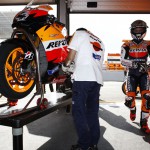The evolution of Grand Prix motocross over the past fifteen years has delivered some important changes: a few desirable, some not quite so, and at the centre of the whirlwind are the riders. Their landscape has shifted to the point where arriving to the very peak of the sport does not necessarily guarantee a hefty income or contract and a team can be a staging point for resources and machinery rather than a salary. The smart ones will look around them and see where they can self-generate sponsorship and boost their social media profile to the point where a single tweet might reach more followers than those watching them at four race meetings combined.
However there seems to a fresh option emerging for those hunting around the peripheries of the narrowing elite of the factory teams: The Substitute. From KTM, Suzuki, Honda, Yamaha, Kawasaki and Husqvarna efforts over the past eighteen months at least one works racer has sat on the sidelines at some point due to injury. Yamaha were perhaps the worst hit. Even fielding six riders across MXGP and MX2 was no guarantee of presence. At one point in 2012 just two representatives made it through the Grand Prix paddock gates whereas fill-ins included Michael Leib, Mel Pocock on otherwise European duty, Carlos Campano and Kristian Whatley.
In a talk with KTM Sport Director Pit Beirer at the Grand Prix of Trentino the German admitted that he was thinking of extending the Red Bull KTM team from four to six riders for 2015. He illustrated the fact that the large orange racing set-up was housing just one racer (the best one at that in 222) with the long-term absence of Ken De Dycker and pointed out that the vast investment in the Husqvarna operations were also hurting due to Tyla Rattray’s finger injury. Beirer commented that the financial expenditure for eighteen rounds was too much not to have bikes on the racetrack and that running a younger, third rider did not involve a great deal more expense in terms of resources – the rigs have the room – but gave KTM extra cover for the war of attrition that is the full MXGP season.
The accidents involving Glenn Coldenhoff (another blow for the fortune-cursed Rockstar Suzuki Europe squad), Todd Waters (again a blow for Husqvarna) and Max Nagl last week have culled three teams in terms of implications for 2014 and potential backing for 2015. Nagl’s injury record is miserable but Waters is a rookie to Grand Prix. The accident itself raises another issue altogether – that of professional racers using busy public circuits for training and the risks they pose through ‘traffic’ and varying levels of experience – but it means that those bosses in Red and White are again scrabbling around to see which athletes are a) free and b) could possibly do a job mid-season.
Pascal Rauchenecker is an example of somebody who could consider the Substitute route by means of association. The 20 year old Austrian has dipped out of Grand Prix for 2014 after two injury hit terms in MX2 and standing over 6ft has decided to get up to speed on a KTM 350SX-F with a well-supported new team in the ADAX MX Masters German Championship. With commitments only on a national level Rauchenecker was available to step-in for Rattray on the factory Husqvarna in both Thailand and Brazil. His appearance meant huge odds. In other words a total lack of testing and last minute adjustment but for the Husky guys he was a sound, promising rider with GP experience who was willing to step-in.
Undoubtedly Rauchenecker would prefer to be at the highest level and admitted he is looking for a way back to GP for 2015 but his situation was not unfavourable, and he might soon be turning out for Antti Pyrhonen’s team again if a more permanent fill-in for Waters is not found for the rest of this year.
Realistically ‘The Substitute’ would suit riders on the periphery of Grand Prix; the not-quite-so-green youngster that is considering European EMX250 competition but could easily jump into MX2 for a team. MXGP and the 350/450 equation is a little more complex but a side project could feasibly be achieved with say funding to contest the still-to-be-properly-born European 300cc two-stroke series and a priority with a testing role as further back-up, and status as a primed replacement if the need arises. This could be a route for some of the athletes in 2015 that will find themselves at a loss with around twenty saddles on the Officially Approved Teams list and the influx of early half that amount drifting up from MX2.
Then again the 23 age limit on the MX2 class could evaporate and many teams and manufacturers could still end up rolling the dice to start and finish racing seasons with their principal riding investments in one piece.
Photo by Ray Archer








